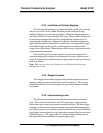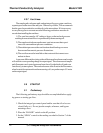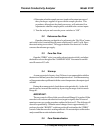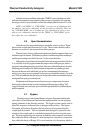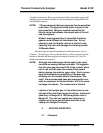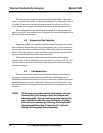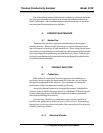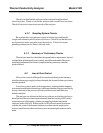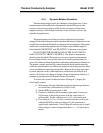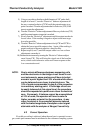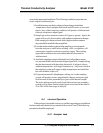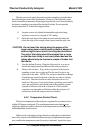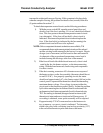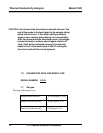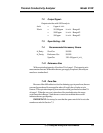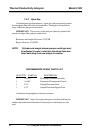
Teledyne Analytical Instruments
19
Thermal Conductivity Analyzer Model 212R
6.2.1 Dynamic Balance Procedure.
The measuring bridge circuit (see schematic) incorporates two 10 turn
potentiometers that are utilized to compensate for minute differences in the
resistive and reactive properties of the hot wire elements and the center
tapped secondary of the bridge transformer in the reference and zero gas
related to the application.
The potentiometers are of the screw driver adjustment type and are
equipped with shaft locking assemblies that have been factory adjusted to create
enough friction so that the shaft will not change position in shipment. The potenti-
ometers are located on the amplifier chassis, and are controlled through two
holes identified “RESISTIVE” and “REACTIVE” on the inner control panel.
DO NOT OPEN THE INNER PANEL OF THE ANALYZER TO
GAIN ACCESS TO THESE CONTROLS. The balance adjustments
should not be disturbed if the analyzer is not up to operating temperature.
Correct bridge balance can only be achieved at operating temperature be-
cause of the inherent thermal junctions within the potentiometers themselves.
The minute voltages produced by contact between the dissimilar materials
within the potentiometers are effectively balanced out in the procedure when
it is accomplished at operating temperature. Because the voltage generated
by these junctions varies with temperature, and because the analyzer will
resolve a 0.25 microvolt change in bridge voltage, temperature stability is a
mandatory prerequisite to the dynamic balance procedure.
To restore zero control within the limits of Range # 1, employ the
following Procedure:
1) With zero gas flowing, adjust the sample and reference gas flowme-
ters to the same value between 0.1 and 0.3 scfh.
2) Set the ZERO potentiometer to 500.
3) Connect a voltmeter to the instrument signal output. Connect an
oscilloscope to the probe point an d set the sweep rate to 5
milliseconds. Set the voltage level so ± 15 volts can be read.
4) If a reading of +15 or –15 volts is indicated on the oscilloscope
with the RANGE switch set to Range # 1 the instrument is
significantly unbalanced. Set to Range #2 and proceed to step 4).
If the voltage is lower in magnitude than + or – 15 skip down to
step 6).



